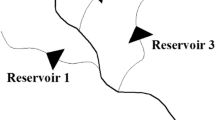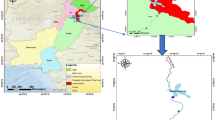Abstract
Dam-break floods have been of increasing concern to safety engineers and decision makers. The presence of complex terrain in inundation areas multiplies the simulation difficulty of flood routing. In previous studies, representing the flood routing parameters empirically does not reflect the characteristics of flood routing, which strongly influences the accurate assessment of the dam-break consequences. The basis for carrying out dangerous reservoir reinforcement is just engineering safety, without considering the actual situation of downstream areas. In this study, a comprehensive risk analysis of the dam-break flood was implemented based on the numerical simulation of flood routing. First, coupled with the volume of fluid method, a three-dimensional k–ɛ turbulence mathematical model was developed for flood routing in complex inundation areas. Then, based on the flow parameters obtained through computational fluid dynamics modeling, the attribute measure methodology was used for the evaluation of consequences combined with the calculation of the dam-break consequences (loss of life, economic loss, social and environmental influence). Furthermore, a methodology containing the combined weight method and the technique for order performance by similarity to ideal solution method was proposed for risk ranking of dangerous reservoirs due to its logical consideration of scalar values that simultaneously account for both the best and worst alternatives. Finally, a sensitivity analysis was performed to provide information about the stability of risk ranking. The aforementioned model and methodology are applied to a case involving five reservoirs in the Haihe River Basin in China for Part II of this study.


Similar content being viewed by others
References
Abderrezzak KE, Paquier A, Mignot E (2009) Modelling flash flood propagation in urban areas using a two-dimensional numerical model. Nat Hazards 50(3):433–460
Alcrudo F, Garcia-Navarro P (1993) A high-resolution Godunov-type scheme in finite volumes for the two-dimensional shallow-water equations. Int J Numer Methods Fluids 16(6):489–505
Australian National Committee on Large Dams (2000) Guidelines on assessment of the consequences of dam failure
Ayağ Z, Özdemir RG (2009) A hybrid approach to concept selection through fuzzy analytic network process. Comput Ind Eng 56(1):368–379
Biscarini C, Francesco SD, Manciola P (2010) CFD modelling approach for dam break flow studies. Hydrol Earth Syst Sc 14(4):705–718
Brown CA, Graham WJ (1988) Assessing the threat to life from dam failure. Water Resour Bull 24(6):1303–1309
Cannata M, Marzocchi R (2012) Two-dimensional dam break flooding simulation: a GIS-embedded approach. Nat Hazards 61(3):1143–1159
Chang CW, Wu CR, Lin CT, Chen HC (2007) An application of AHP and sensitivity analysis for selecting the best slicing machine. Comput Ind Eng 52(2):296–307
Chen CT (2000) Extensions of the TOPSIS for group decision-making under fuzzy environment. Fuzzy Set Syst 114(1):1–9
Chen YG, Price WG, Temarel P (2012) An anti-diffusive volume of fluid method for interfacial fluid flows. Int J Numer Methods Fluids 68(3):341–359
Cheng QS (1997) Attribute recognition theoretical model with application. Acta Sci Nat Univ Pekin 33(1):12–20
Colomer Mendoza FJ, Gallardo Izquierdo A (2009) Environmental risk index: a tool to assess the safety of dams for leachate. J Hazard Mater 162(1):1–9
Dekay ML, McClelland GH (1993) Predicting loss of life in cases of dam failure and flash flood. Risk Anal 13(2):193–205
Dias S, Lee R (1988) A nontraditional methodology for flood stage-damage calculations. Water Resour Bull 24(6):1263–1272
Dimas AA, Fialkowski LT (2000) Large-wave simulation (LWS) of free-surface flows developing weak spilling breaking waves. J Comput Phys 159(2):172–196
Goodarzi E, Shui LT, Ziaei M (2013) Dam overtopping risk using probabilistic concepts—case study: the Meijaran Dam, Iran. Ain Shams Eng J 4(2):185–197
Graham WJ (1999) A procedure for estimating loss of life caused by dam failure. Sediment River Hydraul 6(5):1–43
Hirt CW, Nichols DB (1981) Volume of fluid (VOF) method for the dynamics of free boundaries. J Comput Phys 39(1):201–205
Hreinsson EB, Jónasson K (2003) Monte Carlo based risk analysis in hydroelectric power system expansion planning in the presence of uncertainty in project cost and capacity. In: 38th international universities power engineering conference, Thessaloniki, pp 308–311
Jhnson FA, Iles P (1976) A classification of dam failures. Water Power Dam Constr 28(12):43–45
Jiang WG, Deng L, Chen LY, Wu JJ, Li J (2009) Risk assessment and validation of flood disaster based on fuzzy mathematics. Prog Nat Sci 19(10):1419–1425
Jonkman SN, Penning-Rowsell E (2008) Human instability in flood flows. J Am Water Resour As 44(5):1208–1218
Kahraman C, Cebeci U, Ruan D (2004) Multi-attribute comparison of catering service companies using fuzzy AHP: the case of Turkey. Int J Prod Econ 87(2):171–184
Kalbar PP, Karmakar S, Asolekar SR (2012) Selection of an appropriate wastewater treatment technology: a scenario-based multiple-attribute decision-making approach. J Environ Manag 113:158–169
Kong FS, Wang Y, Yu JY (2004) Fuzzy information combination method of chatter symptom early recognition. J Mech Eng 40(2):108–111
Li L, Wang RZ, Sheng BQ (2006a) Risk assessment and management of dams. China Water & Power Press, Beijing
Li N, Mei YD, Duan WH, Yang N (2006b) Security evaluation for reservoirs based on Vague set theory and group decision-making. Hydropower Autom Dam Monit 30(6):65–69
Montagna F, Bellotti G, Di Risio M (2011) 3D numerical modeling of landslide-generated tsunamis around a conical island. Nat Hazards 58(1):591–608
Pazand K, Hezarkhani A, Ataei M (2012) Using TOPSIS approaches for predictive porphyry Cu potential mapping: a case study in Ahar-Arasbaran area (NW, Iran). Comput Geosci-UK 49:62–71
Peng M, Zhang LM (2012a) Analysis of human risks due to dam-break floods—part 1: a new model based on Bayesian networks. Nat Hazards 64(1):903–933
Peng M, Zhang LM (2012b) Analysis of human risks due to dam break floods—part 2: application to Tangjiashan landslide dam failure. Nat Hazards 64(2):1899–1923
Quecedo M, Pastor M, Herreros MI, Fernández Merodo JA, Zhang QF (2005) Comparison of two mathematical models for solving the dam break problem using the FEM method. Comput Method Appl Mech 194(36–38):3984–4005
Queensland Government National Resources and Mines (2002) Guidelines for Failure Impact Assessment of Water Dams
Robert McNeel & Associates (2011) Rhinoceros, Version 4.0 R9 Rhinoceros Help. Seattle
Saaty TL (1980) The analytic hierarchy process: planning, priority setting, resource allocation. McGraw Hill, New York
Sheng JB, Feng JY, Peng XH (2008) Research on risk analysis of small reservoir dams. Hydrosci Eng 1:28–35
Soltanmohammadi H, Osanloo M, Bazzazi AA (2010) An analytical approach with a reliable logic and a ranking policy for post-mining land-use determination. Land Use Policy 27(2):364–372
Stefanidis S, Stathis D (2013) Assessment of flood hazard based on natural and anthropogenic factors using analytic hierarchy process (AHP). Nat Hazards 68(2):569–585
Sun WW, Li L (2009) Comprehensive hazard assessment model for the consequences caused by the dam failure based on the matter element method. J Saf Environ 9(2):173–176
Sun DY, You WS, Yao QL (2009) Preliminary study on method for ranking dangerous and safety-deficient dams to be strengthened. Water Resour Hydropower Eng 40(7):132–137
Sun YF, Chang HT, Miao ZJ, Zhong DH (2012) Solution method of overtopping risk model for earth dams. Saf Sci 50(9):1906–1912
Tatalovich J, Harris DW (1998) Comparison of failure mode from risk assessment and historical data for Bureau of Reclamation dams, Dam Safety Research Report. DSO-98-01, Dam Safety Office, Materials Engineering and Research Laboratory, U.S. Bureau of Reclamation
Vrijling JK, Verhagen HJ (2005) Probabilistic design of hydraulic structures. Delft University of Technology, Netherlands
Wang ZG, Bowles DS (2006a) Three-dimensional non-cohesive earthen dam breach model. Part 1: theory and methodology. Adv Water Resour 29(10):1528–1545
Wang ZG, Bowles DS (2006b) Three-dimensional non-cohesive earthen dam breach model. Part 2: validation and applications. Adv Water Resour 29(10):1490–1503
Wang RZ, Li L, Sheng JB (2006) On criterion of social and environmental risk of reservoir dams. J Saf Environ 6(1):8–11
Wang WS, Xu WH, Zhai ZJ, Meng QD, Chen TK, Luo YS (2007) Realization of PISO algorithm and comparison convergence characteristics with SIMPLE series algorithms. J North China Inst Water Conserv Hydroelectr Power 28(4):33–36
Wang XL, Yang LL, Sun YF, Song LG, Zhang MX, Cao YB (2008) Three-dimensional simulation on the water flow field and suspended solids concentration in the rectangular sedimentation tank. J Environ Eng-ASCE 134(11):902–911
Wang XL, Li T, Lang J, Zhou SS, Zhang LL, Chen MX (2010) Numerical analysis of solid-liquid two-phase flow on sandstone wastewater of hydropower stations in a rectangular sedimentation tank. Ind Eng Chem Res 49(22):11714–11723
Wang XL, Zhang AL, Chen HH, Sun RR (2012) Three-dimensional numerical simulation of dam-break flood routing in the complex inundation areas. J Hydraul Eng 43(9):1025–1033
Wu CR, Lin CT, Chen HC (2007) Optimal selection of location for Taiwanese hospitals to ensure a competitive advantage by using the analytic hierarchy process and sensitivity analysis. Build Environ 42(3):1431–1444
Xie RZ (1993) Dam break hydromechanics. Shandong Science and Technology Press, Jinan
Yao ZJ, Gao SY (2008) Simulation of building group roughness in dam-break flood flow evolution calculation. Pearl River 5:8–9
Yen BC, Ang AHS (1971) Risk analysis in design of hydraulic projects. In: Proceedings of first inter symposium on stochastic hydraulics, Pittsburg, pp 694–709
Zhao L, Li X, Zhou J (2009) An improved evaluation model for dam failure based on fuzzy AHP. J Saf Environ 9(2):176–180
Zhou KF (2006) Study on the analysis method for loss of life due to dam breach. Dissertation, Nanjing Hydraulic Research Institute
Acknowledgments
The research was supported by the National Basic Research Program of China (973 Program) (Grant no. 2013CB035906), Foundation for Innovative Research Groups of the National Natural Science Foundation of China (Grant no. 51021004), and the Natural Science Foundation of China (Grant no. 51179121). The authors gratefully acknowledge the helpful comments of the editor and referees of this manuscript.
Author information
Authors and Affiliations
Corresponding author
Rights and permissions
About this article
Cite this article
Sun, R., Wang, X., Zhou, Z. et al. Study of the comprehensive risk analysis of dam-break flooding based on the numerical simulation of flood routing. Part I: model development. Nat Hazards 73, 1547–1568 (2014). https://doi.org/10.1007/s11069-014-1154-z
Received:
Accepted:
Published:
Issue Date:
DOI: https://doi.org/10.1007/s11069-014-1154-z




